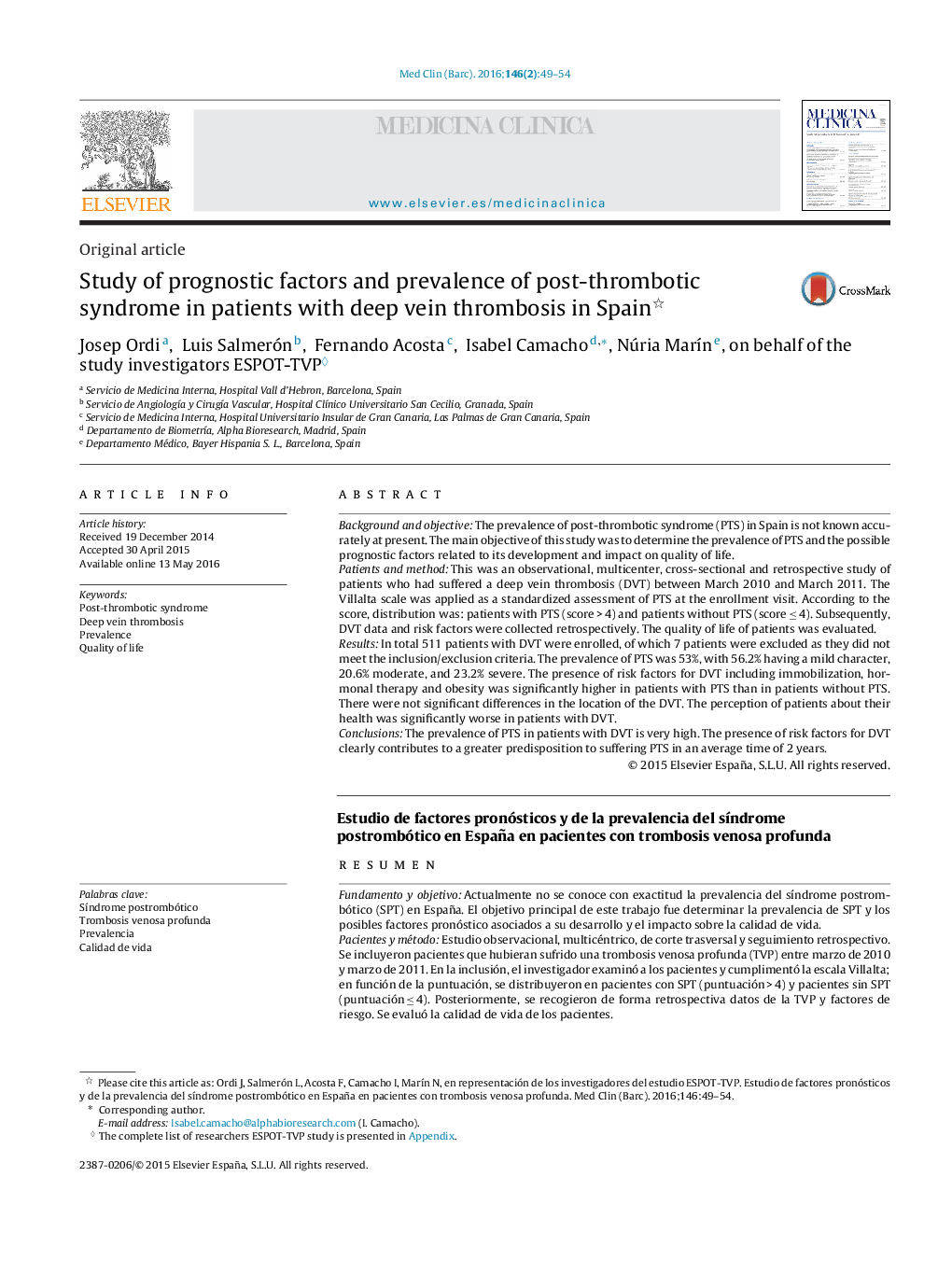| Article ID | Journal | Published Year | Pages | File Type |
|---|---|---|---|---|
| 3805446 | Medicina Clínica (English Edition) | 2016 | 6 Pages |
Background and objectiveThe prevalence of post-thrombotic syndrome (PTS) in Spain is not known accurately at present. The main objective of this study was to determine the prevalence of PTS and the possible prognostic factors related to its development and impact on quality of life.Patients and methodThis was an observational, multicenter, cross-sectional and retrospective study of patients who had suffered a deep vein thrombosis (DVT) between March 2010 and March 2011. The Villalta scale was applied as a standardized assessment of PTS at the enrollment visit. According to the score, distribution was: patients with PTS (score > 4) and patients without PTS (score ≤ 4). Subsequently, DVT data and risk factors were collected retrospectively. The quality of life of patients was evaluated.ResultsIn total 511 patients with DVT were enrolled, of which 7 patients were excluded as they did not meet the inclusion/exclusion criteria. The prevalence of PTS was 53%, with 56.2% having a mild character, 20.6% moderate, and 23.2% severe. The presence of risk factors for DVT including immobilization, hormonal therapy and obesity was significantly higher in patients with PTS than in patients without PTS. There were not significant differences in the location of the DVT. The perception of patients about their health was significantly worse in patients with DVT.ConclusionsThe prevalence of PTS in patients with DVT is very high. The presence of risk factors for DVT clearly contributes to a greater predisposition to suffering PTS in an average time of 2 years.
ResumenFundamento y objetivoActualmente no se conoce con exactitud la prevalencia del síndrome postrombótico (SPT) en España. El objetivo principal de este trabajo fue determinar la prevalencia de SPT y los posibles factores pronóstico asociados a su desarrollo y el impacto sobre la calidad de vida.Pacientes y métodoEstudio observacional, multicéntrico, de corte trasversal y seguimiento retrospectivo. Se incluyeron pacientes que hubieran sufrido una trombosis venosa profunda (TVP) entre marzo de 2010 y marzo de 2011. En la inclusión, el investigador examinó a los pacientes y cumplimentó la escala Villalta; en función de la puntuación, se distribuyeron en pacientes con SPT (puntuación > 4) y pacientes sin SPT (puntuación ≤ 4). Posteriormente, se recogieron de forma retrospectiva datos de la TVP y factores de riesgo. Se evaluó la calidad de vida de los pacientes.ResultadosFueron incluidos 511 pacientes con TVP, de los que se excluyeron 7 por no cumplir algún criterio de inclusión/exclusión. La prevalencia de SPT fue del 53%, siendo un 56,2% de carácter leve, un 20,6%, moderado, y un 23,2%, grave. La presencia de factores de riesgo de TVP, como inmovilización, terapia hormonal y obesidad, fue significativamente mayor en pacientes con SPT frente a pacientes sin SPT. No se encontraron diferencias significativas en la localización de TVP. La percepción del paciente sobre su salud fue significativamente peor en presencia de SPT.ConclusionesLa prevalencia de SPT en pacientes con TVP es muy alta. La presencia de factores de riesgo de TVP contribuye a una mayor predisposición a presentar SPT, en un tiempo medio de 2 años.
